Answered step by step
Verified Expert Solution
Question
1 Approved Answer
If you've studied the 1991 Gulf War or the recent conflict in Iraq, kept up with Arnold Schwarzeneeger films, or watched any TV at



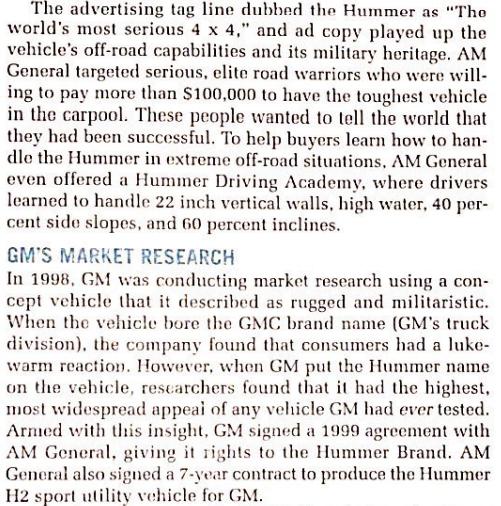
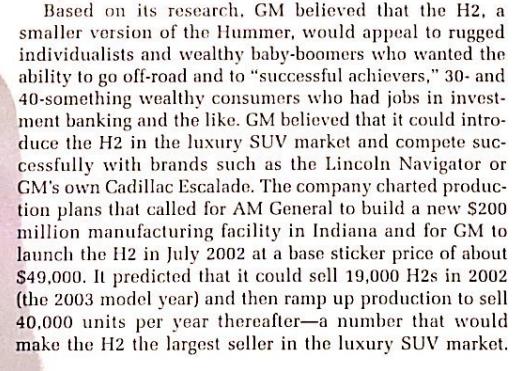
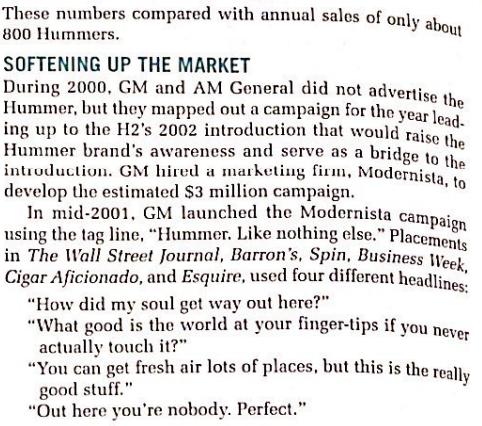
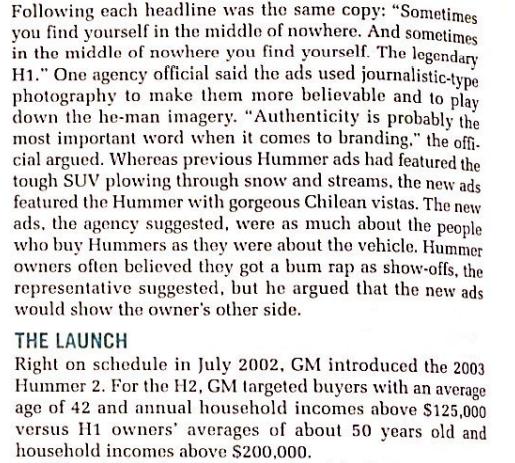
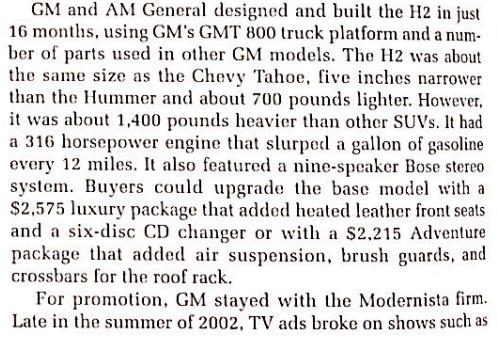
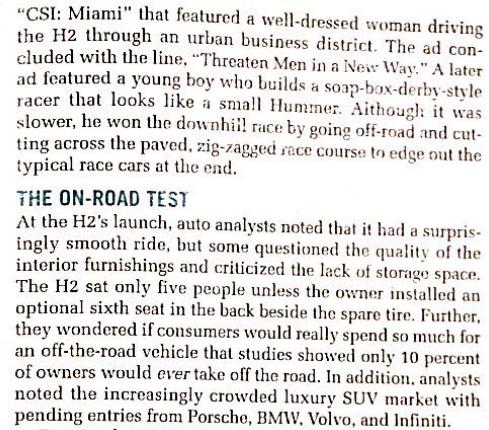
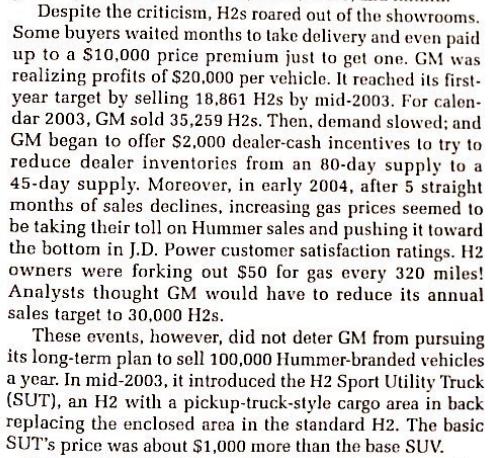

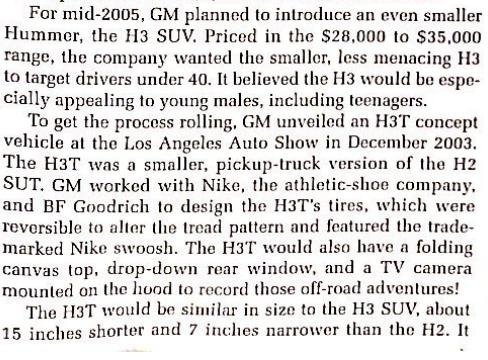
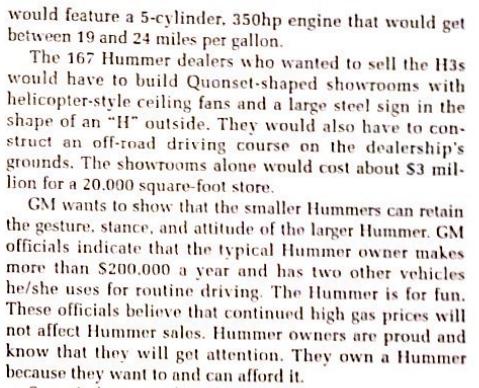
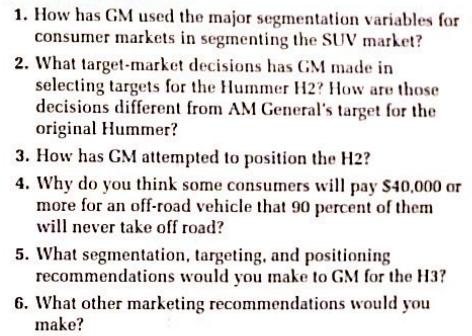

If you've studied the 1991 Gulf War or the recent conflict in Iraq, kept up with Arnold Schwarzeneeger films, or watched any TV at all, you know what a Hummer is. You probably know that the Hummer derives from what soldiers infor- mally call the "Humvee," which is an acronym for the for- mal designation, "High Mobility Multi-Purpose Wheeled Vehicle." In addition to seeing the TV ads, you've probably also seen the original nonmilitary Hummer, the H1, or its smaller offspring, the H2, around town. Well, you're going to see a lot more Hummers. This Hummer story starts in 1979, when AM General, a specialty vehicle manufacturer, earned a contract from the U.S. Army to design the Humvee. The Army wanted a new vehicle to replace its outdated Jeeps. AM General produced the big, boxy Humvee, which labored in relative obscurity until the Gulf War in 1991. TV coverage of the military build- up in advance of the short war and live broadcasts of the war itself introduced the public to the workhorse Humvce. In 1992, AM General, responding to the Humvee's notori- ety, decided to introduce the first civilian version of the Humvee-the Hummer. Weighing in at 7,100 pounds, the Hummer featured a huge, 6.5 liter V-8, turbo-diesel engine that produced 195 horsepower and propelled the Hummer from 0 to 60 miles per hour in a snail-like 18 seconds. However, the Hummer's purpose was not speed. AM General designed it, like its military parent, to take people off the beaten path- way off. The Hummer could plow through water to a depth of 30 inches and climb almost vertical, rocky surfaces. It even had a central tire inflation system that allowed the driver to inflate or deflate the vehicle's tires while on the move. The advertising tag line dubbed the Hummer as "The world's most serious 4 x 4," and ad copy played up the vehicle's off-road capabilities and its military heritage. AM General targeted serious, elite road warriors who were will- ing to pay more than $100,000 to have the toughest vehicle in the carpool. These people wanted to tell the world that they had been successful. To help buyers learn how to han- dle the Hummer in extreme off-road situations, AM General even offered a Hummer Driving Academy, where drivers learned to handle 22 inch vertical walls, high water, 40 per- cent side slopes, and 60 percent inclines. GM'S MARKET RESEARCH In 1998, GM was conducting market research using a con- cept vehicle that it described as rugged and militaristic. When the vehicle bore the GMC brand name (GM's truck division), the company found that consumers had a luke- warm reaction. However, when GM put the Hummer name on the vehicle, rescarchers found that it had the highest, most widespread appeai of any vehicle GM had ever tested. Armed with this insight, GM signed a 1999 agreement with AM General, giving it rights to the Hummer Brand. AM General also signed a 7-year contract to produce the Hummer H2 sport utility vehicle for GM. Based on its research. GM believed that the H2, a smaller version of the Hummner, would appeal to rugged individualists and wealthy baby-boomers who wanted the ability to go off-road and to "successful achievers," 30- and 40-something wealthy consumers who had jobs in invest- ment banking and the like. GM believed that it could intro- duce the H2 in the luxury SUV market and compete suc- cessfully with brands such as the Lincoln Navigator or GM's own Cadillac Escalade. The company charted produc- tion plans that called for AM General to build a new $200 million manufacturing facility in Indiana and for GM to launch the H2 in July 2002 at a base sticker price of about $49,000. It predicted that it could sell 19,000 H2s in 2002 (the 2003 model year) and then ramp up production to sell 40,000 units per year thereafter-a number that would make the H2 the largest seller in the luxury SUV market. These numbers compared with annual sales of only abou 800 Hummers. SOFTENING UP THE MARKET During 2000, GM and AM General did not advertise the Hummer, but they mapped out a campaign for the year lead. ing up to the H2's 2002 introduction that would raise the Hummer brand's awareness and serve as a bridge to the introduction. GM hired a marketing firm, Modernista, to develop the estimated $3 million campaign. In mid-2001, GM launched the Modernista campaign using the tag line, "Hummer. Like nothing else." Placements in The Wall Street Journal, Barron's, Spin, Business Week Cigar Aficionado, and Esquire, used four different headlines "How did my soul get way out here?" "What good is the world at your finger-tips if you never actually touch it?" "You can get fresh air lots of places, but this is the really good stuff." "Out here you're nobody. Perfect." Following each headline was the same copy: "Sometimes you find yourself in the middle of nowhere. And sometimes in the middle of nowhere you find yourself. The legendary H1." One agency official said the ads used journalistic-type photography to make them more believable and to play down the he-man imagery. "Authenticity is probably the most important word when it comes to branding." the offi- cial argued. Whereas previous Hummer ads had featured the tough SUV plowing through snow and streams, the new ads featured the Hummer with gorgeous Chilean vistas. The new ads, the agency suggested, were as much about the people who buy Hummers as they were about the vehicle, Hummer owners often believed they got a bum rap as show-offs, the representative suggested, but he argued that the new ads would show the owner's other side. THE LAUNCH Right on schedule in July 2002, GM introduced the 2003 Hummer 2. For the H2, GM targeted buyers with an average age of 42 and annual household incomes above $125,000 versus H1 owvners' averages of about 50 years old and household incomes above $200,000. GM and AM General designed and built the H2 in just 16 montis, using GM's GMT 800 truck platform and a num- ber of parts used in other GM models. The H2 was about the same size as the Chevy Tahoe, five inches narrower than the Hummer and about 700 pounds lighter. However, it was about 1,400 pounds heavier than other SUVS. It had a 316 horsepower engine that slurped a gallon of gasoline every 12 miles. It also featured a nine-speaker Bose stereo system. Buyers could upgrade the base model with a $2,575 luxury package that added heated leather front seats and a six-disc CD changer or with a $2,215 Adventure package that added air suspension, brush guards, and crossbars for the roof rack. For promotion, GM stayed with the Modernista firm. Late in the summer of 2002, TV ads broke on shows such as "CSI: Miami" that featured a well-dressed woman driving the H2 through an urban business district. The ad con- cluded with the line, "Threaten Men in a New Way." A later ad featured a young boy who builds a soap-box-derby-style racer that looks like a small Hummer. Aithougl: it was slower, he won the downhii! race by going off-road and cut- ting across the paved, zig-zagged race course to edge nut the typical race cars at the end. THE ON-ROAD TEST At the H2's launch, auto analysts noted that it had a surpris- ingly smooth ride, but some questioned the quality of the interior furnishings and criticized the lack of storage space. The H2 sat only five people unless the owner installed an optional sixth seat in the back beside the spare tire. Further, they wondered if consumers would really spend so much for an off-the-road vehicle that studies showed only 10 percent of owners would ever take off the road. In addition. analysts noted the increasingly crowded luxury SUV market with pending entries from Porsche, BMW, Volvo, and Infiniti. Despite the criticism, H2s roared out of the showrooms. Some buyers waited months to take delivery and even paid up to a $10,000 price premium just to get one. GM was realizing profits of $20,000 per vehicle. It reached its first- year target by selling 18,861 H2s by mid-2003. For calen- dar 2003, GM sold 35,259 H2s. Then, demand slowed; and GM began to offer $2,000 dealer-cash incentives to try to reduce dealer inventories from an 80-day supply to a 45-day supply. Moreover, in early 2004, after 5 straight months of sales declines, increasing gas prices seemed to be taking their toll on Hummer sales and pushing it toward the bottom in J.D. Power customer satisfaction ratings. H2 owners were forking out $50 for gas every 320 miles! Analysts thought GM would have to reduce its annual sales target to 30,000 H2s. These events, however, did not deter GM from pursuing its long-term plan to sell 100,000 Hummer-branded vehicles a year. In mid-2003, it introduced the H2 Sport Utility Truck (SUT), an H2 with a pickup-truck-style cargo area in back replacing the enclosed area in the standard H2. The basic SUT's price was about $1,000 more than the base SUV. would feature a 5-cylinder. 350hp engine that would get between 19 and 24 miles per gallon. The 167 Hummer dealers who wanted to sell the H3s would have to build Quonset-shaped showrooms with helicopter-style ceiling fans and a large stee! sign in the shape of an "H" outside. They would also have to con- struct an off-road driving course on the dealership's grounds. The showrooms alone would cost about $3 mil- lion for a 20.000 square-foot store. GM wants to show that the smaller Hummers can retain the gesture. stance, and attitude of the larger Hummer. GM officials indicate that the typical Hummer owner makes more than $200.000 a year and has two other vehicles he/she uses for routine driving. The Hummer is for fun. These officials believe that continued high gas prices will not affect Hummer sales. Hummer owners are proud and know that thev will get attention. They own a Hummer because they want to and can afford it. For mid-2005, GM planned to introduce an even smaller Hummer, the H3 SUV. Priced in the $28,000 to $35,000 range, the company wanted the smaller, less menacing H3 to target drivers under 40. It believed the H3 would be espe- cially appealing to young males, including teenagers. To get the process rolling, GM unveiled an H3T concept vehicle at the Los Angeles Auto Show in December 2003. The H3T was a smaller, pickup-truck version of the H2 SUT. GM worked with Nike, the athletic-shoe company, and BF Goodrich to design the H3T's tires, which were reversible to alter the tread pattern and featured the trade- marked Nike swoosh. The H3T would also have a folding canvas top, drop-down rear window, and a TV camera mounted on the hood to record those off-road adventures! The H3T would be similar in size to the H3 SUV, about 15 inches shorter and 7 inches narrower than the H2. It would feature a 5-cylinder. 350hp engine that would get between 19 and 24 miles per gallon. The 167 Hummer dealers who wanted to sell the H3s would have to build Quonset-shaped showrooms with helicopter-style ceiling fans and a large stee! sign in the shape of an "H" outside. They would also have to con- struct an off-road driving course on the dealership's grounds. The showrooms alone would cost about $3 mil- lion for a 20.000 square-foot store. GM wants to show that the smaller Hummers can retain the gesture. stance, and attitude of the larger Hummer. GM officials indicate that the typical Hummer owner makes more than $200.000 a year and has two other vehicles he/she uses for routine driving. The Hummer is for fun. These officials believe that continued high gas prices will not affect Hummer sales. Hummer owners are proud and know that thev will get attention. They own a Hummer because they want to and can afford it. 1. How has GM used the major segmentation variables for consumer markets in segmenting the SUV market? 2. What target-market decisions has GM made in selecting targets for the Hummer H2? How are those decisions different from AM General's target for the original Hummer? 3. How has GM attempted to position the H2? 4. Why do you think some consumers will pay S40,000 or more for an off-road vehicle that 90 percent of them will never take off road? 5. What segmentation, targeting, and positioning recommendations would you make to GM for the H3? 6. What other marketing recommendations would you make? Some industry analysts, however, wonder if introducing more Hummers will dilute the brand's image and even steal sales from other GM vehicles. They argue that the decision to introduce smaller and lower-priced Hummers is a risky move, especially given the brand's aspirational nature. Maybe so, but GM is already discussing the possibility of an H4.
Step by Step Solution
★★★★★
3.38 Rating (154 Votes )
There are 3 Steps involved in it
Step: 1
1 Segmentation aims at division of market into different segments which can be clearly defined accessed actionable and have a growth potential Kotler Armstrong 2017GM has used various bases to segment ...
Get Instant Access to Expert-Tailored Solutions
See step-by-step solutions with expert insights and AI powered tools for academic success
Step: 2

Step: 3

Ace Your Homework with AI
Get the answers you need in no time with our AI-driven, step-by-step assistance
Get Started


